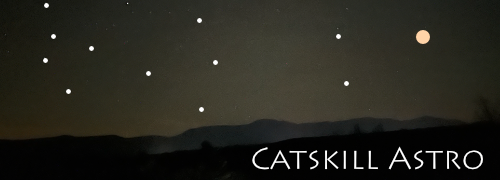Messier Objects
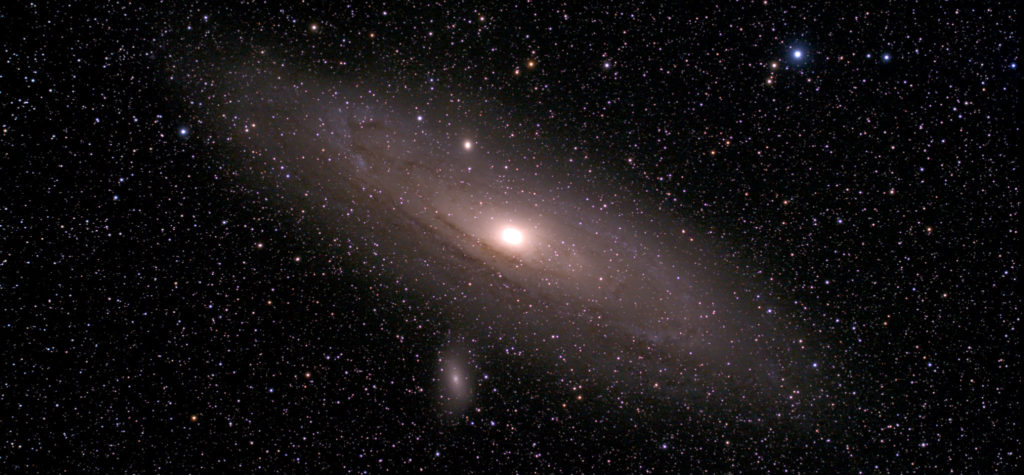
Page 6 of 11
Messier observations 51-60 of 110 total to date.
| Catalog # | Thumbnail | Title/link | Description |
|---|---|---|---|
| M51 | 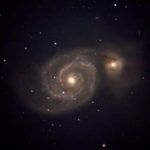 |
M51 / Arp 85 / Whirlpool Galaxy | After a gap of 20 months Messier recorded M51 on January 11, 1774, roughly 3 months after his discovery (#22 so far): "Very faint nebula, without stars, near the eye of the Northern Greyhound [hunting dog], below the star Eta of 2nd magnitude of the tail of Ursa Major: M. Messier discovered this nebula on October 13, 1773, while he was watching the comet visible at that time". <--> As galaxies go, with modern equipment, this is a very bright and familiar target, which I've captured successfully multiple times. Feb 19, 2024 was one of the clearest evenings of the Winter, and decided to stay on it to achieve "near" astrophotography quality despite using EAA techniques. The two galactic centers and the connecting dust lanes are clearly evident. Just beautiful! We've included two "bonus" observations: first an observation using my EVO 9.25, early in my EAA career. The other on July 15, 2024 on a so-so night using my EdgeHD to capture it using Bin2 on my ASI294 camera over 37m, and processed in Affinity Photo. |
| M52 |  |
Bubble Nebula with M52 and NGC 7538 | After a gap of 9 months, Messier recorded his discovery of M52 (#23) on September 7, 1774; `Cluster of very small [faint] stars, mingled with nebulosity, which can be seen only with an achromatic telescope. It was when he observed the Comet which appeared in this year that M. Messier saw this cluster, which was close to the comet on the 7th of September 1774; it is below the star d Cassiopeiae: that star was used to determine [the position of] both the cluster of stars & the comet.' <--> I do have a closeup view of M52 which you can find by clicking on the "Related Observation" button, but I much prefer this one which shows it in its fascinating context. The red HII region is an area of star birthing, and M52 was probably a product of this region 35 million years or so ago. So it's nice to see them together, metaphorically mother and teenage offspring. Captured on a night when I was trying to figure out what to capture at an upcoming star party. This is a lovely view, under good conditions, though I was in need of testing some other potential targets for the party and couldn't spend as much time on it as I'd have liked. That said, this configuration of my Askar V at 384mm-f/4.5 is easily 5x as fast as the EdgeHD. Very cool. |
| M53 | 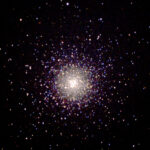 |
M53 / NGC 5024 | Discovered 1775 by Johann Elert Bode, Messier added M53 on February 26, 1777, a gap of 2 years and 5 months. He notes: "Nebula without stars discovered below & near Coma Berenices.... This nebula is round and conspicuous. The Comet of 1779 was compared directly with this nebula, & M. Messier has reported it on the chart of that comet, which will be included in the volume of the Academy for 1779. Reviewed on April 13, 1781" <--> M53 may rank only 14th and 18th respectively among Messier GCs in brightness and diameter. But if you like cluster with a round, nearly edge-to-edge bright core, this would be up there for you. The Blue and Orange star "tendrils" offer some relief from strict symmetry. This was one of the few GC observations where I wasn't observing on a sub-par night. I ook advantage of a late evening to continue my Messier quest at a time when the moon was still low enough to allow a quality capture. |
| M54 |  |
M54 / NGC 6715 | Messier recorded his discovery of M54 (#24) after a gap of 1 year and 5 months on July 24, 1778: `Very faint nebula, discovered in Sagittarius; its center is brilliant & it contains no star". <--> Ranked (tied) at 18th and 16th respectively among Messier GC's, it's below median on both counts. It's also incredibly challenging to observe given its -31° declination. That Messier managed it from Paris at nearly 49° latitude is astonishing. I've been despairing how to capture a set of Messier targets low in the southern sky. M54 is one of these, never really rising above my treeline. This was one of the last targets on my list, and by the time I got to it, my SeeStar's platesolving wouldn't definitely identify it. I could see it on my screen so started it capturing, and it tracked OK. I had decided to travel to the Ashokan Reservoir, which has a very low southern horizon... The resolution here is poor given the small size of target and low angle. |
| M55 | 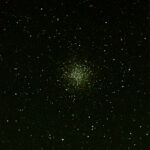 |
M55 / NGC 6809 | Messier added M55 to his list on the same day as M54, July 24, 1778. This is not surprising given their close proximity. Messier comments: "A nebula which is a whitish spot, of about 6' extension, its light is even and does not appear to contain any star. This nebula has been discovered by M. l'Abbe de LaCaille, see Mem. Acad. 1755, p. 194.... M. Messier has looked for it in vain on July 29, 1764, as reported in his memoir." <--> M55 is 7th and 6th respectively among Messier GC's in terms brightness and size. You can tell by comparison to M54 if you compare the uncropped images in the galleries, since both were taken with the identical setup. I've been despairing how to capture a set of Messier targets low in the southern sky. M55 is one of these, never really rising above my treeline. I sympathize with Charles Messier who had received correspondence about this object, but tried for 4 years to actually view it because it was so low! Paris is at a higher latitude than the Catskills, so it's impressive he managed it at all. I had decided to travel to the Ashokan Reservoir, which has a very low southern horizon... |
| M56 | 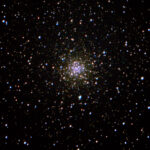 |
M56 / NGC 6779 | Discovered (#25) and reported by Messier on January 23, 1779 after a gap of 6 months: "Nebula without stars, having little light; M. Messier discovered it on the same day as he found the comet of 1779, January 19. On the 23rd, he determined its position by comparing it with the star 2 Cygni.... M. Messier reported it on the chart of the comet of 1779." <--> This is one of the faintest and smallest Messier GCs, ranked 27 and 24 respectively. It truly illustrates the reach of the EdgeHD at f/10 if you compare the imagery to M54 (ranked 18/16) imaged by the Seestar. Late night capture under rising moon. Interesting globular, which can often looks just like a ball. This object is thought to have been part of a dwarf galaxy that merged into the Milky Way. |
| M57 | 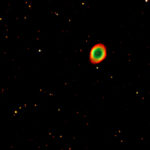 |
M57 / Ring Nebula | Messier posted his second discovery (#26) on the same date as M56: January 31, 1779. Messier could barely resolve the object, and struggled to describe it in the listing: `A cluster of light between Gamma & Beta Lyrae, discovered when looking for the Comet of 1779, which has passed it very close: it seems that this patch of light, which is round, must be composed of very small stars: with the best telescopes it is impossible to distinguish them; there stays only a suspicion that they are there. M. Messier reported this patch of light on the Chart of the Comet of 1779. M. Darquier, at Toulouse, discovered it when observing the same comet [in February], and he reports: "Nebula between gamma and beta Lyrae; it is very dull, but perfectly outlined; it is as large as Jupiter & resembles a planet which is fading".' It is this comment which is the origin of the "planetary nebula" monikier that has confused novice astronomers ever since. <--> Of course, with modern equipment this is one of the brightest and easiest to observe planetary nebula, certainly in the northern hemisphere. |
| M58 |  |
M58 / NGC 4579 | Another Messier discovery (#27) while comet hunting, recorded April 15, 1779, a gap of 10 weeks. "Very faint nebula discovered in Virgo... The slightest light for illuminating the micrometer wires makes it disappear. M. Messier reported it on the chart of the Comet of 1779, which is located in the volume of the Academy for the same year." <--> One of the brightest galaxies in the Virgo Cluster, it was nevertheless the most distant galaxy in the Messier catalog. It's still classified as an "intermediate" spiral though the bright "bar" is quite distinct. |
| M59 | 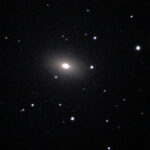 |
M59 / NGC 4621 | This is the second of three entries posted by Messier on April 15, 1779, discovered while mapping the path of the Comet of 1779 through Virgo. Credit for the discovery is given to Johann Gottfried Koehler who recorded it on April 11, 1779, four days earlier. Messier's catalog entry: "Nebula in Virgo & in the neighborhood of the preceding [M58].... [I]t is of the same light as the above, equally faint. M. Messier reported it on the Chart of the Comet of 1779." <--> For me, this was a very quick capture on a very dark, clear night (before the moon rose). Frankly, while Messier can say "it is of the same light", capturing a spiral galaxy with lots of structure [M58] versus an elliptical galaxy with none, are very different EAA targets, with the latter requiring much less integration time than the former. The "related observation" button takes you to a wide-field image that shows a significant portion of the Virgo cluster including M59 (see also annotated version). |
| M60 | 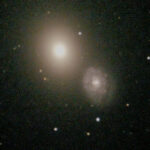 |
Arp 116 / M60 / NGC 4649-4647 | This is the third of three entries posted by Messier on April 15, 1779, discovered while mapping the path of the Comet of 1779 through Virgo. Credit for the discovery is given to Johann Gottfried Koehler who observed it on April 11, 1779, four days earlier. Messier's entry: "Nebula in Virgo, a little more distinct than the two preceding [M58 and M59].... M. Messier reported it on the Chart of the Comet of 1779. He discovered these three nebulae while observing this Comet which passed very close to them. The latter passed so near on April 13 & 14 that the one & the other were both in the same field [of view] of the refractor, and he could not see it; it was not until the 15th, while looking for the Comet, that he perceived the nebula. These three nebulae don't appear to contain any star." Clearly, Messier saw only a single nebula, not two interacting ones. <--> In my image, NGC 4647 makes a lovely contrast with M60... a spiral galaxy with lots of structure vs. elliptical with virtually none other than a bright center. Certainly does appear that M60 is perturbing NGC 4647. Assuming NGC 4647 was close to circular when formed, the attraction has elongated its current shape and given the center of mass a slight kink to the south (towards M60). |
